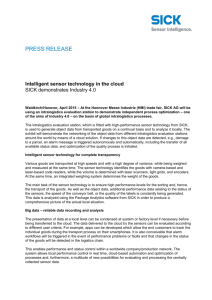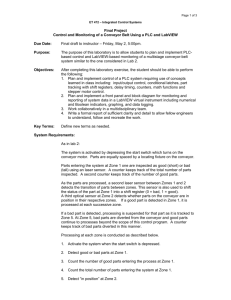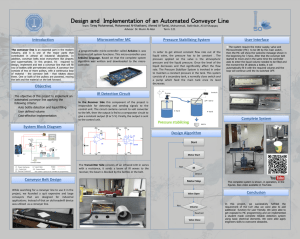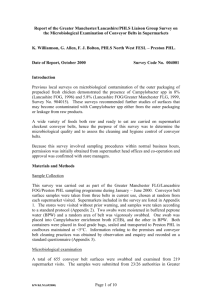IAA_Level_06,072012
advertisement
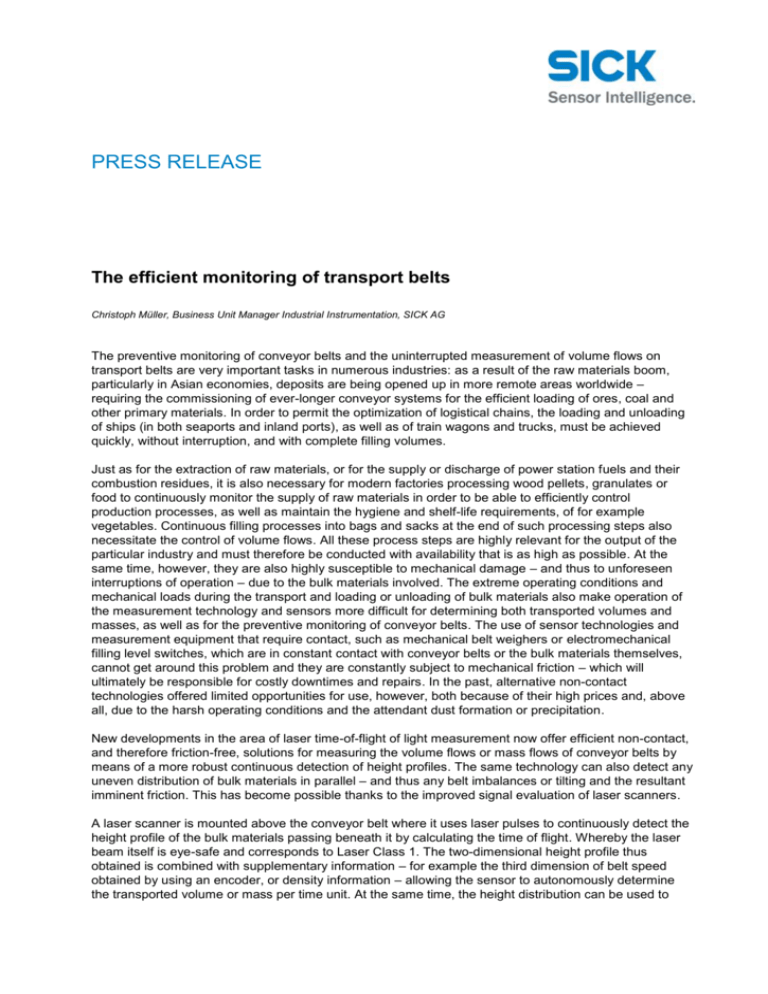
PRESS RELEASE The efficient monitoring of transport belts Christoph Müller, Business Unit Manager Industrial Instrumentation, SICK AG The preventive monitoring of conveyor belts and the uninterrupted measurement of volume flows on transport belts are very important tasks in numerous industries: as a result of the raw materials boom, particularly in Asian economies, deposits are being opened up in more remote areas worldwide – requiring the commissioning of ever-longer conveyor systems for the efficient loading of ores, coal and other primary materials. In order to permit the optimization of logistical chains, the loading and unloading of ships (in both seaports and inland ports), as well as of train wagons and trucks, must be achieved quickly, without interruption, and with complete filling volumes. Just as for the extraction of raw materials, or for the supply or discharge of power station fuels and their combustion residues, it is also necessary for modern factories processing wood pellets, granulates or food to continuously monitor the supply of raw materials in order to be able to efficiently control production processes, as well as maintain the hygiene and shelf-life requirements, of for example vegetables. Continuous filling processes into bags and sacks at the end of such processing steps also necessitate the control of volume flows. All these process steps are highly relevant for the output of the particular industry and must therefore be conducted with availability that is as high as possible. At the same time, however, they are also highly susceptible to mechanical damage – and thus to unforeseen interruptions of operation – due to the bulk materials involved. The extreme operating conditions and mechanical loads during the transport and loading or unloading of bulk materials also make operation of the measurement technology and sensors more difficult for determining both transported volumes and masses, as well as for the preventive monitoring of conveyor belts. The use of sensor technologies and measurement equipment that require contact, such as mechanical belt weighers or electromechanical filling level switches, which are in constant contact with conveyor belts or the bulk materials themselves, cannot get around this problem and they are constantly subject to mechanical friction – which will ultimately be responsible for costly downtimes and repairs. In the past, alternative non-contact technologies offered limited opportunities for use, however, both because of their high prices and, above all, due to the harsh operating conditions and the attendant dust formation or precipitation. New developments in the area of laser time-of-flight of light measurement now offer efficient non-contact, and therefore friction-free, solutions for measuring the volume flows or mass flows of conveyor belts by means of a more robust continuous detection of height profiles. The same technology can also detect any uneven distribution of bulk materials in parallel – and thus any belt imbalances or tilting and the resultant imminent friction. This has become possible thanks to the improved signal evaluation of laser scanners. A laser scanner is mounted above the conveyor belt where it uses laser pulses to continuously detect the height profile of the bulk materials passing beneath it by calculating the time of flight. Whereby the laser beam itself is eye-safe and corresponds to Laser Class 1. The two-dimensional height profile thus obtained is combined with supplementary information – for example the third dimension of belt speed obtained by using an encoder, or density information – allowing the sensor to autonomously determine the transported volume or mass per time unit. At the same time, the height distribution can be used to reliably detect the above-mentioned tilting or any one-sided loading so that a warning signal can be transmitted. What is so special about this design structure is the robust detection of the height profile even in the case of interfering factors such as bulk material mists, dust or rain. This has been made possible by means of new signal evaluation technologies that can reliably filter out the correct height profile signal from amongst the numerous echoes. Thus the German sensor producer SICK offers, for example, laser scanners with so-called multi-echo technology, whereby the software algorithm can reliably determine the correct signal from among the various reflected laser pulses and dependably suppress the measurement of interfering echoes caused by mist or rain. Maximum resolution of the height profile – and thus a high measurement accuracy – and the measurement of rapidly moving transport belts with speeds of up to 30 meters per second can be achieved as a result of the devices’ rapid scan frequencies of up to 75 Hz and speedy response times. For the further processing of signals, the SICK Bulkscan system offers six switching outputs that can be individually occupied, for example as warning or pulse outputs, as well as continuous outputs such as, for example, transmission of measurement values via TCP/IP (Ethernet). Whereby the processing and preparation of measurement values takes place directly in the sensor which, therefore, also has two inputs. No supplementary measurement value computer is required. This results in simple installation and commissioning. The advantages of such as a system compared to mechanical solutions are self-evident – greater availability of transport and filling plants, no need for maintenance, and the longer service life of the sensor system due to the lack of mechanical friction. SICK is one of the world's leading manufacturers of sensors and sensor solutions for industrial applications. Founded in 1946 by Dr.-Ing. e. h. Erwin Sick, the company is headquartered in the German town of Waldkirch, in the Breisgau region near the city of Freiburg. It is a technology and market leader, maintaining a global presence with more than 50 subsidiaries and equity investments as well as numerous representative offices. In the 2014 fiscal year, SICK had around 7,000 employees worldwide and generated Group revenues of €1,099.8 million. Page 2 of 2

